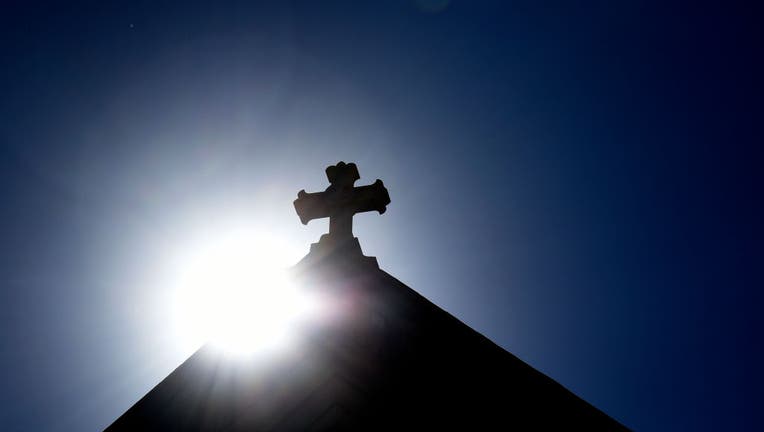More Americans identify as "religiously unaffiliated" than 10 years ago, especially this group

FILE - The sun rises behind a stone cross atop the historic Cathedral Basilica of St. Frances of Assisi in Santa Fe, New Mexico. ((Photo by Robert Alexander/Getty Images))
LOS ANGELES - In the last decade, the number of Americans identifying as religiously unaffiliated—often referred to as "nones"—has surged, according to data from the 2023 Public Religion Research Institute (PRRI) survey.
In 2023, 27% of Americans said they had no religious affiliation, a jump from 21% in 2013. This group includes atheists, agnostics, and people who describe their religious identity as "nothing in particular."
A variety of social, cultural, and generational factors have driven this rise. These include a growing diversity of belief systems, secularization, and the increasing distance younger generations maintain from organized religion.
Key factors contributing to the rise in "nones":
- Generational shifts: Younger Americans are less likely to be raised in religious households.
- Cultural secularization: A shift away from religious norms has contributed to secular values.
- Diverse belief systems: More religious options and non-traditional spiritual beliefs have emerged.
Who is driving the rise in the "religiously unaffiliated"?
While religious disaffiliation has increased across all age groups, middle-aged Americans (aged 30-49) have seen the most significant rise. According to the PRRI survey, this group experienced an 11-point increase from 23% in 2013 to 34% in 2023.
Interestingly, younger Americans (aged 18-29), who already had higher rates of religious disaffiliation, saw only a slight increase, from 32% in 2013 to 36% in 2023.
Quick facts:
- 30-49-year-olds: Religious disaffiliation jumped from 23% to 34% between 2013 and 2023.
- 18-29-year-olds: Slight rise from 32% to 36% during the same period.
Reasons for disaffiliation in younger and middle-aged Americans:
- Erosion of traditional institutions: Younger generations are less likely to follow their parents' religious practices.
- Social media influence: Younger Americans are more exposed to alternative belief systems and secular perspectives online.
- Political polarization: Many Americans feel alienated from religion due to its perceived ties to conservative politics.
What is the impact of religious disaffiliation?
The decline in religious affiliation—especially among traditionally dominant white Christian groups—has far-reaching implications.
White evangelical Protestants, once a major religious and political force, have seen their share of the population plummet from 23% in 2006 to just 13% in 2023. Similarly, white mainline Protestants and white Catholics have experienced smaller, but notable, declines.
This shift could reshape the cultural and political landscape in the U.S. as secular values and policies gain more prominence.
- Political change: White evangelical Christians, a key voting bloc for Republicans, are losing numbers.
- Cultural shift: Secular values like LGBTQ+ rights and separation of church and state may see increased focus.
- Institutional challenges: Religious institutions are grappling with declining membership and participation.
Notable statistics:
- White evangelical Protestants: Declined from 23% in 2006 to 13% in 2023.
- White mainline Protestants: Reduced from 19% in 2007 to 13% in 2023.
- White Catholics: Dropped from 16% in 2008 to 12% in 2023.
How have Christian groups of color and non-Christian religions changed?
While white Christians have seen a decline, Christians of color and non-Christian religious groups have remained relatively stable over the past decade. Christians of color now make up 25% of the U.S. population, while non-Christian religious groups such as Jewish Americans, Muslims, Buddhists, and Hindus have collectively held steady at around 6% of the population.
Breakdown of religious diversity in the U.S.:
- Christians of color: 25% of the population, including 8% Black Protestants, 8% Hispanic Catholics, and 4% Hispanic Protestants.
- Non-Christian groups: 6% of the population, including 2% Jewish Americans, 1% Muslims, 1% Buddhists, and 1% Hindus.
Despite the rise in religious disaffiliation, religious diversity remains a significant feature of the American landscape.
The increasing number of Americans identifying as religiously unaffiliated is one of the most striking trends in the country's evolving religious landscape. This shift—driven by younger and middle-aged generations—has profound implications for religious institutions, cultural values, and political dynamics. As more people step away from organized religion, the long-term effects on American society will continue to unfold.

